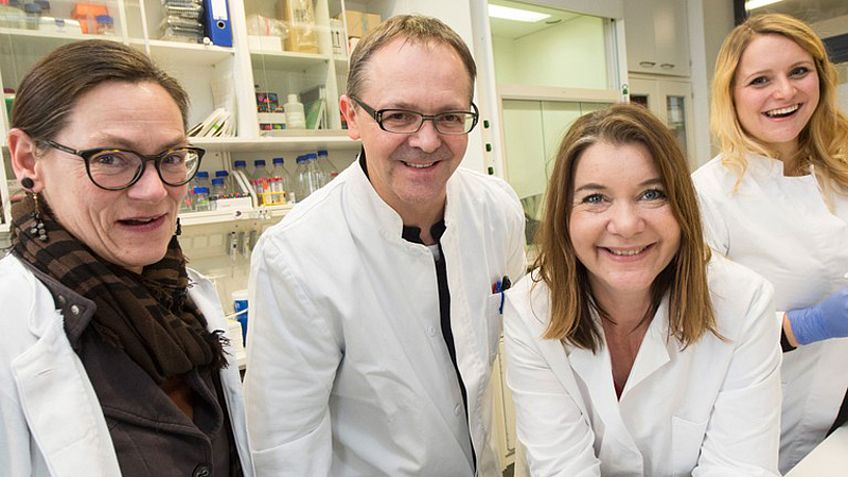BioImaging
To obtain detailed insights into the molecular function of novel proteins, a highly precise visualization of these proteins is required, providing information about: the expression level, the subcellular localization, the movement and the co-localization with other factors, Thus, BioImaging is an essential technique for almost all projects in the lab and employs cutting edge methods of fluorescence microscopy and electron microscopy. The combined technologies of Fluorescence microscopy enable noninvasive imaging of living cells, tissues and embryos, without disturbing their development thus providing a better understanding of biological processes during normal development and in a gene specific Knock Out model. Transmission electron microscopy is applied for ultrastructural analysis of e.g. subcellular localization of organelles and proteins and plasma-membranes in wild type versus specimen from genetic Knock Out models.
Microscope equipment:
BioImaging equipment used by the lab includes the confocal microscopes ZEISS LSM710, the ZEISS Two/Photon microscope LSM780, the Leica TCS SP2 and the transmission electron microscope ZEISS Libra120.
ZEISS LSM 710 Duoscan Confocal Microscope
The ZEISS LSM710 uses an inverted Axioobserver Z1 stand and provides a duoscan system for simultaneous photomanipulation and imaging.
Applications: Co-Localization, Z sectioning (One XY point experiment, no XY motorised stage), FRET, FRAP, PA-GFP, Uncaging, spectral fingerprinting and unmixing of novel or overlapping fluorochromes, High speed imaging (12,5 frames / sec at 34 channels; 256x256 pxls).
Excitation laser lines:
405nm (Diode, 6,7mW), 458nm (Ar, 1,4mW), 488nm (Ar, 6,1mW), 514nm (Ar, 4,2mW) 561nm (4,8mW), 633nm (HeNe, 1,5mW)
Fluorescence Filters:
DAPI Filter #49, excitation G365, beamsplitter FT 395, emission BP 445/50
GFP Filter #38, excitation BP 470/40, beamsplitter FT 495, emission BP 525/50
Rhodamine Filter #20, excitation BP546/12, beamsplitter FT560, emission BP575/640
Objective equipment
5x NA 0.25, Fluar, WD = 12,5mm
10x NA 0.3, PlanNeofluar, WD = 5,2mm
25x NA 0.8, PlanNeofluar, DIC, Water Immersion, WD = 0,21mm
63x NA 1.3, PlanNeofluar, DIC, Water/Glycerol/Oil Immersion
Imaging software: ZEN 2010
Leica LSM SP2 Confocal Microscope
The Leica SP2 inverted confocal microscope uses variable spectral detection system instead of traditional emission filters.
Applications: Good for fixed samples. Co-Localization, Z sectioning (One XY point experiment, no XY motorised stage), FRET, FRAP (including software).
Excitation laser lines and Fluorescence Filters:
The system has a limited number of laser lines for excitation and the dyes are limited by these. Any dye that is excited at one of these following wavelengths can be used: 405; 458; 488; 514; 543; and 633 nm
Filter cubes for DAPI, FITC and TRITC are installed for standard fluorescence viewing prior to scanning. Transmitted light illumination is also available.
Objectives:
Leica HC PL APO 10x NA 0.4 Dry
Leica HC PL APO 20x NA 0.7 Dry
Leica HCX APO L 40x NA 0.8 Water
Leica PL APO 63x NA 1.3 Oil
Leica HCX PL APO CS 100x NA 1.25 Oil
Imaging software: Leica TCS analysis andLCS MicroLab License for SP2








